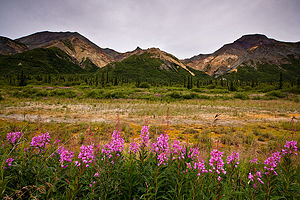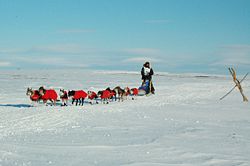Land ownership and protected lands
The Arctic National Wildlife Refuge in the northeast corner of Alaska covers 19,049,236 acres (77, 090 sq km). Much of the northwest Arctic coastal area west of the Colville River is included in the National Petroleum Reserve–Alaska, which covers about 23,000,000 acres (93,100 km²). The land between these two set-aside areas has seen considerable oil and gas exploration, the establishment of an oil extraction industry centered on the Prudhoe Bay, and the construction of an oil pipeline and access road heading south.
According to an October 1998, report by the United States Bureau of Land Management, approximately 65 percent of Alaska is owned and managed by the U.S. federal government as national forests, national parks, national wildlife refuges, national wild and scenic rivers, and national conservation areas. Among these, the Bureau of Land Management manages 87 million acres (350,000 sq km), or 23.8 percent of the state, which area includes the National Petroleum Reserve–Alaska. The Arctic National Wildlife Refuge is managed by the United States Fish and Wildlife Service.
The remaining 35 percent of the state land area is apportioned between the State of Alaska (24.5 percent) and thirteen regional (and dozens of local) Native corporations created under the Alaska Native Claims Settlement Act (10 percent), and various private interests (less than 1 percent).
Culture
Some of Alaska's popular annual events are the World Ice Art Championships in Fairbanks, the Blueberry Arts Festival in Ketchikan, the Sitka Whale Fest, and the Stikine River Garnet Fest in Wrangell. The Stikine River features the largest springtime concentration of American Bald Eagles in the world.
Various dog mushing races are held around the state, but the best known is the Iditarod Trail Sled Dog Race, following a 1,150 mile (1850 km) trail from Anchorage to Nome. The race commemorates the famous 1925 serum run to Nome in which mushers and dogs like Balto took much-needed medicine to the diphtheria-stricken community of Nome when all other means of transportation had failed. Portions of the original Iditarod Trail were used by the Native American Inuit and Athabaskan peoples hundreds of years before the arrival of Russian fur traders in the 1800s, but use of the trail reached its peak between the late 1880s and the mid 1920s as miners arrived to dig coal, and later, gold. Mushers from all over the world come to Anchorage each March to compete for both cash prizes and prestige.
The Alaska Native Heritage Center celebrates the rich heritage of Alaska's eleven cultural groups. The center's purpose is to enhance self-esteem among Native people and to encourage cross-cultural exchanges among all people.
Alaska's two professional sports teams are the Alaska Aces, an ECHL hockey team, and the Alaska Wild, a new Intense Football League football team.
Hiking, camping, and cross-country skiing, as well as hunting and fishing, are all very popular in Alaska.
http://www.newworldencyclopedia.org/entry/Alaska#Land_ownership_and_protected_lands


